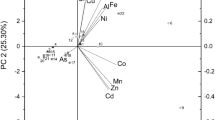Abstract
Pacific oysters were harvested from November to March at Miyazaki and Miyagi in Japan. From biometric analysis, the condition indices (CICG; high CICG indicates large oyster meat) of oysters were high in February and March at Miyazaki whereas CICG at Miyagi showed high values in December and February. Lipid content in oysters at Miyagi harvested in February was the highest. Glycogen content was high in oysters harvested in February from both cultivation areas. In November, the calcium content in oysters harvested at Miyazaki was the highest. Taurine was the predominant free amino acid in oysters, at concentrations of 2180–3230 mg/100 g dry sample. Glutamate was the predominant component of total amino acid in oysters, at concentrations of 4530–6000 mg/100 g. The percentage of eicosapentaenoic acid (EPA) in total lipid of oysters did not show significant differences between harvesting months. Based on all analyses, oysters from Miyazaki showed good quality in March with high CICG, glycogen, and lipid contents, whereas oysters from Miyagi showed good quality in February. These analysis data including not only condition indices but also biochemical composition might be useful parameters allowing establishment of evaluation criteria.

Similar content being viewed by others
References
Chew KK (1990) Global bivalve shellfish introductions. World Aquac 21:9–22
Orban E, Di Lena G, Masci M, Nevigato T, Casini I, Caproni R, Gambelli L, Pellizzato M (2004) Growth, nutritional quality and safety of oysters (Crassostrea gigas) cultured in the lagoon of Venice (Italy). J Sci Food Agric 84:1929–1938
Hosoi M, Kubota S, Toyohara M, Toyohara H, Hayashi I (2003) Effect of salinity change on free amino acid content in Pacific oyster. Fish Sci 69:395–400
Surh J, Ryu J-S, Kwon H (2003) Seasonal variations of fatty acid compositions in various Korean shellfish. J Agric Food Chem 51:1617–1622
Crosby MP, Gale LD (1990) A review and evaluation of bivalve condition index methodologies with a suggested standard method. J Shellfish Res 9:233–237
Hand RE, Nell JA (1999) Studies on triploid oysters in Australia XII. Gonad discolouration and meat condition of diploid and triploid Sydney rock oysters (Saccostrea commercialis) in five estuaries in New South Wales, Australia. Aquaculture 171:181–194
Imai T, Sasaki S (1961) Study on the breeding of the Japanese oyster, Crassostrea gigas. Tohoku J Agric Res 12:125–171
Fuke S (1994) Taste-active components of seafoods with special reference to umami substances. In: Shahidi F, Botta JR (eds) Seafoods: chemistry, processing technology and quality. Blackie Academic & Professional, Glasgow, pp 115–139
Konosu S, Yamaguchi K (1982) The flavor components in fish and shellfish. In: Martin RE, Flick G, Hebard CE, Ward DR (eds) Chemistry and biochemistry of marine food products. AVI publishing Company, Westport, CN, pp 367–404
Leaf A, Weber PC (1988) Cardiovascular effects of n-3 fatty acids. New Engl J Med 318:549–557
AOAC (1995) Official methods of analysis. Association of Official Analytical Chemists, Washington, DC
Özden Ö, Erkan N, Deval MC (2009) Trace mineral profiles of the bivalve species Chamelea gallina and Donax trunculus. Food Chem 113:222–226
PS Chen Jr, Tribara YT, Warner H (1956) Microdetermination of phosphorus. Anal Chem 28:1756–1758
Carroll NV, Longley RW, Roe JJ (1956) The determination of glycogen in liver and muscle by use of anthrone reagent. J Biol Chem 220:583–593
Ogushi M, Harada R (1999) Proximate composition and extractable components of sun-dried gonads of sea cucumber (Konoko) and corresponding marine products. J Jpn Soc Nutr Food Sci 52(2):79–84
Bligh EG, Dyer WJ (1959) A rapid method of total lipid extraction and purification. Can J Biochem Physiol 37:911–917
AOCS (1989) Official method Ce 1b-89. Official method for marine oil fatty acid composition by GLC. In: Firestone D (ed) Official methods and recommended practices of the American Oil Chemists’ Society, 4th edn. AOCS Press, Champaign
Hochberg Y (1988) A sharper Bonferonni procedure for multiple tests of significance. Biometrika 75:800–803
Oliveira ACM, Himelbloom B, Crapo CA, Verholt C, Fong Q, RaLonde R (2006) Quality of Alaskan maricultured oysters (Crassostrea gigas): a one-year survey. J Food Sci 71:532–543
Linehan LG, O’Conner TP, Burnell G (1999) Seasonal variation in the chemical composition and fatty acid profile of Pacific oysters (Crassostrea gigas). Food Chem 64:211–214
Dridi S, Romdhane MS, Elcafsi M (2007) Seasonal variation in weight and biochemical composition of the pacific oyster, Crassostrea gigas in relation to the gametogenic cycle and environmental conditions of the Bizert lagoon, Tunisia. Aquaculture 26:238–248
The Ministry of Education, Culture, Sports, Science, Technology, Japan (2010) Standard table of food composition in Japan. Government Publications Service Center, Tokyo
Beltran-Lugo AI, Maeda-Martines AN, Pacheco-Aguilar R, Nolasco-Soria HG (2006) Seasonal variations in chemical, physical, textural, and microstructural properties of adductor muscles of pacific lions-paw scallop (Nodipecten Subnodosus). Aquaculture 258:619–632
Fuentes A, Fernandez-Segovia I, Escriche I, Serra JA (2009) Comparison of physico-chemical parameters and composition of mussels (Mytilus galloprovincialis Lmk.) from different Spanish origins. Food Chem 112:295–302
The Ministry of Education, Culture, Sports, Science, Technology, Japan (2010) Standard tables of food composition in Japan, amino acid composition of foods. Government Publications Service Center, Tokyo
Curz-Romeo MC, Kerry JP, Kelly AL (2008) Fatty acids, volatile compounds and colour changes in high-pressure-treated oysters (Crassostrea gigas). Innov Food Sci Emerg Tech 9:54–61
Acknowledgments
The authors thank Dr. Makoto Terayama (Miyazaki Prefectural Fisheries Experimental Station) and Mr. Nasumi Tomikawa (Kesennuma Miyagi Prefectural Fisheries Experimental Station) for the generous supply of oyster samples.
Author information
Authors and Affiliations
Corresponding author
Rights and permissions
About this article
Cite this article
Futagawa, K., Yoshie-Stark, Y. & Ogushi, M. Monthly variation of biochemical composition of Pacific oysters Crassostrea gigas from two main cultivation areas in Japan. Fish Sci 77, 687–696 (2011). https://doi.org/10.1007/s12562-011-0364-5
Received:
Accepted:
Published:
Issue Date:
DOI: https://doi.org/10.1007/s12562-011-0364-5




